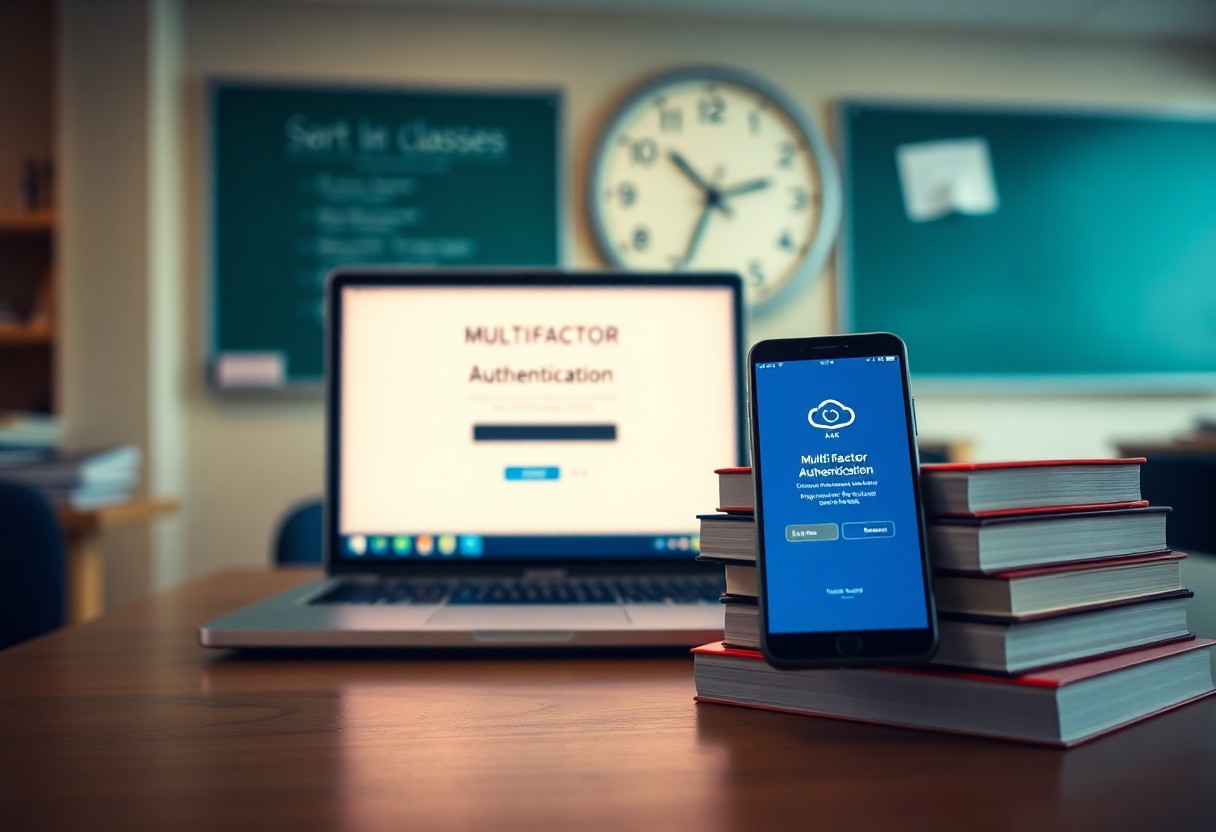Many students underestimate the importance of online security as classes approach. With the rise of phishing attacks targeting educational institutions, it is important to implement phishing-resistant multi-factor authentication (MFA) to protect your sensitive information. By setting up MFA, you can significantly reduce the risk of unauthorized access to your accounts, ensuring your personal data remains secure throughout the school year. This proactive measure not only safeguards your information but also fosters a safer online environment for everyone.
Key Takeaways:
- Implement phishing-resistant MFA to enhance account security for all users.
- Ensure all accounts are enrolled in MFA before the academic term begins.
- Conduct training sessions to familiarize users with MFA processes and phishing threats.
The Escalating Threat Landscape of Phishing Attacks
Phishing attacks have become increasingly sophisticated, evolving from simple email scams to complex, multi-channel campaigns. Cybercriminals leverage social engineering tactics to exploit trust and manipulate individuals into revealing sensitive information. Phishing attacks are now more frequent, with organizations reporting a sharp rise in targeted attempts, especially as they embrace remote learning and collaboration tools. Your institution must remain vigilant, as these threats not only compromise individual accounts but can also jeopardize the entire network.
Current Statistics and Trends
Recent studies show that approximately three-quarters of organizations experienced phishing attacks within the last year, with educational institutions facing a 40% increase in targeted incidents. Notably, nearly one in five phishing emails managed to bypass standard security measures, indicating a need for stronger defense strategies, especially in the bustling back-to-school season.
How Phishing Targets Educational Institutions
Educational institutions are prime targets for phishing due to their vast amounts of personal information and relatively relaxed cybersecurity measures. Attackers may impersonate administrative staff or create fake accounts resembling peers to trick students and faculty into providing login credentials or sensitive data. With an increasing reliance on digital platforms for communication and learning, these tactics have become alarmingly effective.
Phishing campaigns directed at educational institutions often exploit seasonal events, like the start of a new academic year, by sending fake enrollment notifications or urgent requests for payment. For instance, a phishing email might claim to require immediate action to secure a student’s spot in a class, prompting students to enter private information on a fraudulent site. This strategic targeting not only increases the likelihood of success for attackers but also underscores the urgency for your institution to enhance its cybersecurity measures through phishing-resistant MFA and comprehensive training programs for staff and students.
The Crucial Role of Multi-Factor Authentication (MFA)
Multi-Factor Authentication (MFA) significantly enhances your security by requiring two or more verification methods before granting access. This layered approach protects sensitive information, reducing the risk of unauthorized access. Relying solely on a password is insufficient in today’s threat landscape, where credential theft is rampant. By integrating MFA into your access protocols, you deter cybercriminals and safeguard personal and institutional data effectively.
Why Traditional Authentication Methods Fall Short
Traditional authentication methods, like passwords, are increasingly inadequate due to their vulnerability to phishing attacks and data breaches. Typically, passwords can be easily compromised through various tactics such as social engineering or brute-force attacks. A staggering 81% of hacking-related breaches involve stolen or weak passwords. This reality emphasizes that solely relying on these methods puts your sensitive information at risk.
The Benefits of Phishing-Resistant MFA
Phishing-resistant MFA offers enhanced protection by utilizing multiple verification methods that are tougher for attackers to bypass. Unlike traditional authentication, phishing-resistant options often include biometric factors or hardware tokens, which cannot be easily replicated. This means even if your password becomes compromised, your accounts remain secure as long as the secondary verification method is intact.
By employing phishing-resistant MFA, you strengthen your overall security posture. For example, the implementation of a security key, which requires physical presence for verification, can thwart attempts even if someone has stolen your password. This multifaceted defense significantly decreases the chances of successful phishing schemes. According to studies, organizations utilizing MFA see a reduction in breaches by up to 99%, showcasing its effectiveness in protecting sensitive data. Transitioning to sophisticated MFA not only secures your accounts but also builds trust within your community as a proactive stance against cyber threats.
Implementing Phishing-Resistant MFA: Steps to Take
Establishing phishing-resistant MFA involves a series of strategic actions to ensure robust security for your institution. Begin by assessing the current security landscape and identifying high-risk accounts. Conduct vulnerability assessments to understand where threats are most likely to occur. Once the analysis is complete, roll out MFA progressively, prioritizing sensitive applications and administrative accounts. Employee training on the new processes is vital, ensuring everyone understands how to use MFA effectively while emphasizing the risks of bypassing these measures.
Choosing the Right MFA Solution
Selecting an MFA solution tailored to your institution’s needs is vital. Consider factors like user experience, integration capabilities, and robust security features, such as biometric authentication or hardware tokens. Evaluate solutions like Google Authenticator, Microsoft Authenticator, or enterprise-level options that support single sign-on. Conduct a thorough comparison of features to ensure you choose a solution that aligns with both your security objectives and user convenience.
Integrating MFA into Existing Systems
Seamlessly integrating MFA into your current systems ensures minimal disruption and optimal security. Start with pilot testing in less critical environments to gauge user response and technical performance. Identify the specific applications that require MFA and utilize APIs for smoother integration. Coordination with IT teams helps to align MFA requirements with existing workflows. Ensure adequate documentation and user support to build familiarity, facilitating a smoother rollout throughout your institution.
Integration can leverage existing authentication frameworks to promote synergy between systems. Focus on applying MFA selectively to critical services, such as email and cloud storage, where sensitive data resides. Collaborating with software vendors can yield enhanced compatibility, easing the transition. Develop a phased implementation plan that incorporates feedback from users and IT staff, refining the process for greater efficiency. This approach not only strengthens security but also encourages acceptance among users as they experience the benefits firsthand.
Ensuring Compliance and Best Practices
Adopting phishing-resistant MFA is not only a security measure but also a compliance requirement for many educational institutions. Implementing strong authentication methods helps you meet various legal and regulatory standards, safeguarding both institutional data and student information. Aligning your MFA strategies with best practices positions your institution as a leader in security while decreasing vulnerability to cyber threats.
Regulatory Requirements for Educational Institutions
Your institution must comply with regulations like the Family Educational Rights and Privacy Act (FERPA) and the Health Insurance Portability and Accountability Act (HIPAA). These regulations mandate stringent data protection measures, including secure access controls. Implementing MFA aligns with these requirements, thereby enhancing your data security practices and keeping sensitive information safe from unauthorized access.
Key Policies to Support MFA Implementation
Establishing clear policies is vital for effective MFA implementation. You should define access controls, including user roles and permissions, while conducting regular audits of your systems. These policies not only facilitate compliance but also encourage a culture of security awareness among staff and students, ensuring everyone understands the importance of protecting sensitive information.
Developing detailed policies involves outlining the process for enrolling in MFA, specifying which accounts require it, and establishing communication protocols for potential security incidents. Training sessions can highlight the benefits of MFA, allowing users to grasp its significance in protecting personal and institutional data. Additionally, consider setting up a formal review process for these policies to adapt them as threats evolve, demonstrating your institution’s commitment to ongoing security improvements.
Real-World Implications: Success Stories and Lessons Learned
Implementing phishing-resistant MFA has led to significant improvements in security for many educational institutions. Success stories highlight how colleges and universities have effectively reduced incidents of unauthorized access and data breaches. By integrating MFA into their systems, these institutions not only safeguarded sensitive information but also enhanced user confidence in their digital platforms.
Institutions That Thwarted Attacks with MFA
Several universities have successfully thwarted cyber attacks using MFA, with Yale University amongst those reporting a 90% reduction in phishing incidents after implementation. By requiring MFA for all faculty and student access, they have significantly improved the safeguarding of personal and institutional data against unauthorized access attempts.
Common Pitfalls and How to Avoid Them
Many institutions face obstacles in effectively integrating MFA, such as user resistance and inadequate training. A common mistake is assuming all staff and students are familiar with MFA processes. Regular training sessions and clear communication about the importance and benefits of MFA can help alleviate concerns and ensure a smoother transition.
Resistance from users often stems from a lack of understanding regarding the necessity of MFA. Some may view MFA as cumbersome, leading to hesitance in adoption. Additionally, poor communication about the setup process may create confusion. To counteract these issues, providing comprehensive tutorials, ongoing support, and emphasizing the security benefits will increase user buy-in. Engaging students and faculty in the discussion around MFA and success stories from peers can further enhance acceptance and encourage proactive participation.
Summing up
The implementation of phishing-resistant multi-factor authentication (MFA) before classes start significantly enhances your security against cyber threats. By prioritizing this setup, you ensure that your sensitive information and online activities are better protected. This proactive measure not only safeguards your personal data but also instills confidence in your digital experiences. Take the time to establish these security practices now, so you can focus on your academic success with peace of mind.



